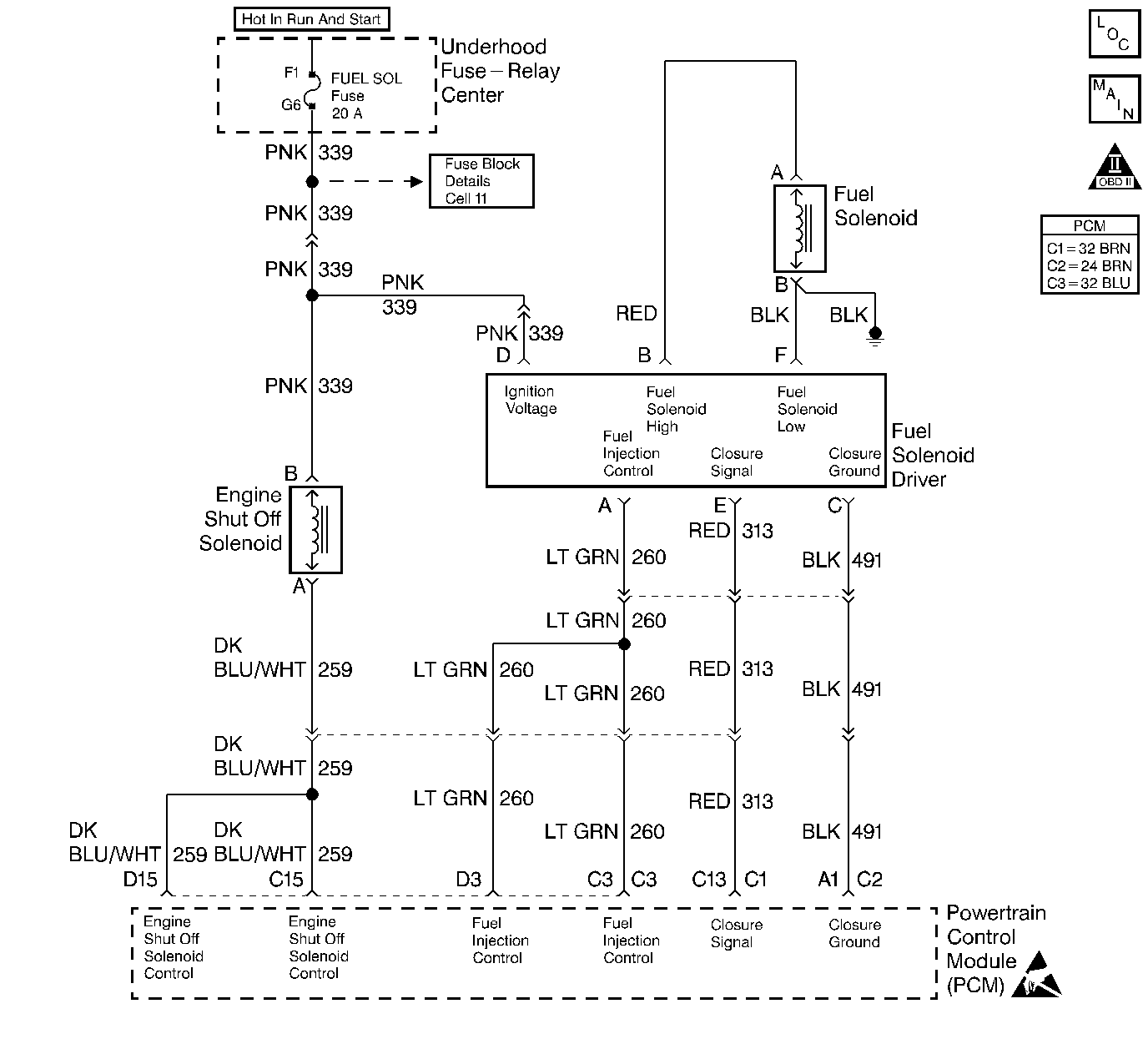
Circuit Description
This table assumes that battery condition and engine cranking speed is OK, quantity and quality of fuel is OK and glow plug system is operating OK.
Diagnostic Aids
If no trouble is found and the cause of an Engine Cranks But Will Not Run has not been found, check for:
| • | Proper cranking speed, 100 RPM cold --180 RPM hot (a scan tool can be used to check the cranking speed by pulling the FUEL SOL fuse and monitoring Engine Speed on the scan tool while cranking). |
| • | Water or foreign material in fuel system. |
| • | Basic engine problem. |
If the Crankshaft position sensor and the Optical/Fuel Temperature are disconnected or malfunctioning at the same time, a Engine Cranks But Will Not Run condition will exist.
Test Description
The number(s) below refer to the step number(s) on the Diagnostic Table.
-
This step checks for proper cranking speed (see Diagnostic Aids).
-
This step will check the ground wire on the injection pump (wire located on top of pump).
-
This step will determine if the injection pump or wiring is at fault.
-
This step will determine if the fuel injection control voltage is present by probing at the black/gray 4 wire jumper harness instead of at the 6 wire pump connector.
Step | Action | Value(s) | Yes | No |
|---|---|---|---|---|
1 |
Important: Before clearing the DTCs, use the Scan Tool Capture Info in order to record the Freeze Frame and the failure records for reference, as the data will be lost when the Clear Info function is used. Was the Powertrain On-Board Diagnostic (OBD) System Check performed? | -- | ||
2 | Check for proper condition of batteries. Refer to Engine Electrical. Is the condition of batteries OK? | -- | ||
3 | Check for adequate fuel in the tank. Is the fuel at an adequate level? | -- | ||
4 | Check the quality of fuel. Refer to Fuel System Contamination. Is the fuel quality OK? | -- | ||
5 | Check the glow plug system operation. Refer to Glow Plug System. Are the glow plugs operating OK? | -- | ||
Check for proper cranking speed. Refer to Engine Electrical. Is the cranking speed OK? | -- | |||
7 | Check for a restriction in the fuel return system. Refer to Fuel System. Does the fuel return system operate properly? | -- | ||
Check the injection pump ground wire (located on top of the injection pump). Is the ground OK? | -- | |||
9 | Turn the ignition ON. Does the MIL come ON? | -- | ||
10 | Install the scan tool. Does the scan tool display data? | -- | ||
11 |
Is there fuel at the each injection line? | -- | ||
Disconnect the Optical/Fuel temperature sensor. Does the vehicle start? | -- | |||
Is the voltage greater than or equal to the specified value? | 1.2 V | |||
14 |
Is the test light ON? | -- | ||
15 |
Is the test light ON? | -- | ||
16 | Replace the fuel injection pump. Refer to Fuel Injection Pump Replacement . Is the action complete? | -- | -- | |
17 | The injection system is OK. Is the action complete? | -- | Go to Symptoms | -- |
18 | Check the fuel inject control circuit for an open or ground between the fuel solenoid driver and the PCM. Was a problem found? | -- | ||
19 | Check the closure ground circuit for an open between the fuel solenoid driver and the PCM. Was a problem found? | -- | ||
20 | Inspect the fuel solenoid driver connector and PCM connector for proper connection. Was a problem found? | -- | ||
21 | Repair the open in the ignition feed circuit. Is the action complete? | -- | -- | |
22 | Repair the circuit as necessary. Is the action complete? | -- | -- | |
23 | Make the appropriate repairs. Is the action complete? | -- | -- | |
24 | Replace the PCM. Important: The new PCM must be programmed. Refer to Powertrain Control Module Replacement/Programming . Is the action complete? | -- | -- | |
25 |
Does the engine start and continue to run? | -- | ||
26 |
Are there any DTCs displayed? | -- | -- | |
27 | Use the Scan Tool in order to select Capture Info, Review Info. Are there any DTCs displayed that have not been diagnosed? | -- | Go to the Applicable DTC Table | System OK |
